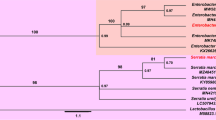Abstract
The in vitro effect of four isolates of the nematophagous fungi Duddingtonia flagrans (AC 001), Monacrosporium sinense (SF 53), and Pochonia chlamydosporia (VC 1 and VC 4) on eggs of Ascaris suum was evaluated. One hundred thousand A. suum eggs were plated on 2% water–agar with the grown isolates and control without fungus. After 7, 14, and 21 days, 100 eggs were removed and classified according to the following parameters: type 1, lytic effect without morphological damage to eggshell; type 2, lytic effect with morphological alteration of embryo and eggshell; and type 3, lytic effect with morphological alteration of embryo and eggshell, besides hyphal penetration and internal egg colonization. P. chlamydosporia showed ovicidal activity (p < 0.01), mainly of the type 3 effect, on A. suum eggs in the studied intervals of 13.3% (isolate VC 1) and 17.3% (isolate VC 4), 13.9% (VC 1) and 17.7% (VC 4), and 19% (VC 1) and 20% (VC4), respectively, at 7, 14, and 21 days. The other fungi showed no type 3 effect. P. chlamydosporia is a potential biological control agent of A. suum eggs.
Similar content being viewed by others
References
Ayres M, Ayres JRM, Ayres DL, Santos AS (2003) Aplicações estatísticas nas áreas de ciências biológicas, Brasília
Araújo JV, Santos MA, Ferraz S (1995) Efeito ovicida de fungos nematófagos sobre ovos embrionados de Toxocara canis. Arq Bras Med Vet Zootec 47:37–42
Araújo JV, Mota MA, Campos AK (2004a) Controle biológico de helmintos parasitos de animais por fungos nematófagos. Rev Bras Parasitol Vet 13:165–170
Araújo JV, Guimarães MP, Campos AK (2004b) Control of bovine gastrointestinal nematodes parasites using pellets of the nematode trapping fungus Monacrosporium thaumasium. Ciênc Rural 34:457–463
Araújo JV, Freitas BW, Vieira TC, Campos AK (2006a) Avaliação do fungo predador de nematóides Duddingtonia flagrans sobre larvas infectantes de Haemonchus contortus e Strongyloides papillosus de caprinos. Rev Bras Parasitol Vet 15:76–79
Araújo JV, Assis RCL, Campos AK, Mota MA (2006b) Efeito antagônico de fungos predadores dos gêneros Monacrosporium, Arthrobotrys e Duddingtonia sobre larvas infectantes de Cooperia sp. e Oesophagostomum sp. Arq Bras Med Vet Zootec 58:373–380
Braga FR, Araújo JV, Campos AK, Carvalho RO, Silva AR, Tavela AO, Maciel AS (2007) Observação in vitro da ação dos isolados fúngicos Duddingtonia flagrans, Monacrosporium thaumasium e Verticillium chlamydosporium sobre ovos de Ascaris lumbricoides (Lineu, 1758). Rev Soc Bras Med Trop 40:356–358
Campos AK, Mota MA, Araújo JV, Cecon PR (2004) Atividade predatória, crescimento radial e esporulação e fungos predadores de nematóides Monacrosporium spp, submetidos à criopreservação. Ciênc Rural 24:465–469
Campos AK, Araújo JV, Assis RCL, Grandra JR, Guimarães MP (2007) Viabilidade de formulação peletizada do fungo nematófago Monacrosporium sinense, no controle biológico de nematóides parasitos gastrintestinais de bezerros. Arq Bras Med Vet Zootec 59:14–20
Castro AA, Oliveira CRC, Anjos DHS, Ornellas EI, Bittencourt REP, Araújo JV, Sampaio IBM, Rodrigues MLA (2003) Potencial dos fungos nematófagos Arthrobotrys sp. e Monacrosporium thaumasium para o controle de larvas de ciatostomíneos de eqüinos (Nematoda: Cyathostominae). Rev Bras Parasitol Vet 12:49–53
Chandrawathani P, Jamnah O, Waller PJ, Larsen M, Gillespie AT, Zahari WM (2003) Biological control of nematode parasites of small ruminants in Malaysia using the nematophagous fungus Duddingtonia flagrans. Vet Parasitol 117:173–183
Dimander SO, Höglund J, Uggla A, Spörndly E, Waller PJ (2003) Evaluation of gastro-intestinal nematode parasite control strategies for first-season grazing cattle in Sweden. Vet Parasitol 111:192–209
Fontenot ME, Miller JE, Peña MT, Larsen M, Gillespie A (2003) Efficiency of feeding Duddingtonia flagrans chlamydospores to grazing ewes on reducing availability of parasitic nematode larvae on pasture. Vet Parasitol 118:203–213
Gams W, Zare R (2001) A revision of Verticillium sect. Prostrata. III. Generic classification. Nova Hedwig 73:329–337
Gomes AS, Araújo JV, Ribeiro RCF (1999) Differential in vitro pathogenicity of predatory fungi of the genus Monascrosporium for phytonematodes, free-living nematode and parasitic nematodes of cattle. Braz J Med Biol Res 32:79–83
Kahn LP, Norman TM, Walkden-Brown SW, Crampton A, O’connor LJ (2007) Trapping efficacy of Duddingtonia flagrans against Haemonchus contortus at temperatures existing at lambing in Australia. Vet Parasitol 146:83–89
Larsen M (1999) Biological control of helminths. Int J Parasitol 29:139–146
Lysek H (1976) Classification of ovicide fungi according to type of ovicidity. Acta University Palacki Olumue 76:9–13
Lysek H (1978) A scanning electron microscope study of the effects of an ovicidal fungus on the eggs of Ascaris lumbricoides. Parasitol 77:139–141
Lysek H, Sterba J (1991) Colonization of Ascaris lumbricoides eggs by the fungus Verticillium chlamydosporium Goddard. Folia Parasitol 38:255–259
Lysek H, Fassatiová O, Pineda NC, Hernández NL (1982) Ovicidal fungi in soils of Cuba. Folia Parasitol 29:265–270
Mizobutsi E, Ferraz S, Ribeiro RCF (2000) Avaliação do parasitismo de diversos isolados fúngicos em ovos de Heterodera glycines e Meloidogyne javanica. Nematol Bras 24:167–172
Morgan-Jones G, White JF, Rodríguez-Kábana R (1983) Phytonematode pathology: ultrastuctural studies. Parasitism of Meloidogyne arenaria eggs by Verticillium chlamydosporium. Nematropica 13:245–260
Mota MA, Campos AK, Araújo JV (2003) Controle biológico de helmintos parasitos de animais: estágio atual e perspectivas futuras. Pesq Vet Bras 23:93–100
Roepstorff A, Nansen P (1994) Epidemiology and control of helminth infections in pigs under intensive and nonintensive production systems. Vet Parasitol 54:69–85
Roppa L (1998) Suinocultura brasileira. Suin Ind 20:24–32
Stirling GR, West LM (1991) Fungal parasites of root-knot nematodes eggs from tropical and sub tropical regions of Australia. Australas Plant Pathol 20:149–154
Urquhart GM, Armour J, Duncan JL, Dunn AM, Jennings FW (1998) Parasitologia Veterinária. 2° Ed., Editora Guanabara Koogan, Rio de Janeiro, p. 273
Waghorn TS, Leathwick DM, Chen LY, Skipp RA (2003) Efficacy of the nematode-trapping fungus Duddingtonia flagrans against three species of gastro-intestinal nematodes in laboratory faecal cultures from sheep and goats. Vet Parasitol 118:227–234
Author information
Authors and Affiliations
Corresponding author
Rights and permissions
About this article
Cite this article
Araújo, J.V., Braga, F.R., Silva, A.R. et al. In vitro evaluation of the effect of the nematophagous fungi Duddingtonia flagrans, Monacrosporium sinense, and Pochonia chlamydosporia on Ascaris suum eggs. Parasitol Res 102, 787–790 (2008). https://doi.org/10.1007/s00436-007-0852-9
Received:
Accepted:
Published:
Issue Date:
DOI: https://doi.org/10.1007/s00436-007-0852-9




